You can find many filtration technologies in a shower head water filter. Each one helps make water better and keeps you healthy. Common shower head filters use activated carbon, KDF, calcium sulfite, vitamin C, and mineral stones. These different filters take out chlorine, heavy metals, and other bad things from shower water. Studies show a shower water filter can help stop dryness, irritation, and damage to skin and hair. Picking a shower head that filters water gives you cleaner water and better quality for your daily routine.
Key Takeaways
Shower head water filters use different technologies. These include activated carbon, KDF, calcium sulfite, vitamin C, and mineral stones. They help remove chlorine, heavy metals, and other bad things from water.
Multi-stage filters use a few methods to clean water better. They protect your skin and hair. They also make your shower feel nicer.
You should change your filter every 2 to 6 months. This keeps your water clean. It also helps your filter work well.
Filtered water can help stop dryness and irritation. It can also help stop damage to your skin and hair. This makes showers healthier and more fun.
Pick a filter that matches your water and what you need. Test your water to find the best filter for your home.
Filtration in Shower Head Filters
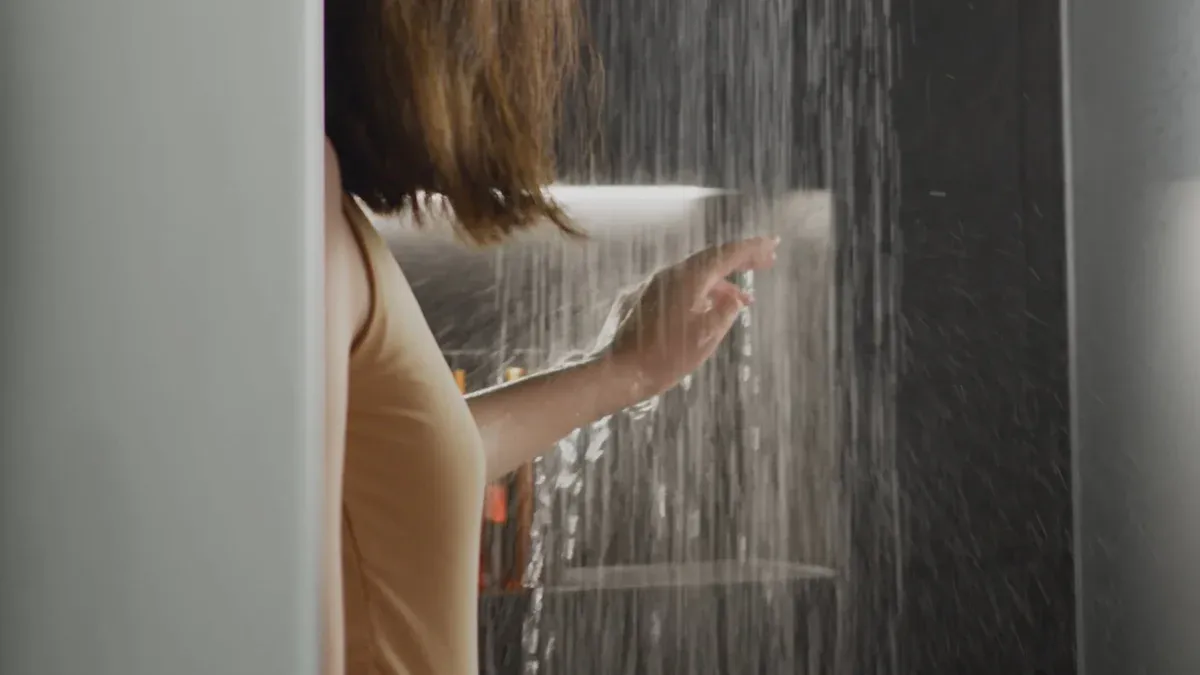
When you check a shower head water filter, you will see different types of filtration. These methods work together to clean your water. Each one removes certain impurities. This makes your shower safer and more pleasant. Here are the main filtration technologies found in modern shower head filters.
Activated Carbon
Activated carbon is used a lot in shower head filters. It is a special kind of carbon with a big surface area. Activated carbon absorbs impurities as water goes through it. It helps lower harsh chemicals like chlorine and pesticides. It also helps stop lime scale, dirt, and bad smells. By reducing chlorine and other chemicals, activated carbon helps your skin and hair stay healthy.
Tip: Activated carbon works best in cold or warm water. Hot water over 80°F can harm the carbon. This can let trapped impurities back into your shower.
Most shower head filters with activated carbon need changing every 3 to 6 months. This depends on how much you use it and your water quality. If you notice less water pressure or smell chlorine again, it is time to change the filter.
KDF (Kinetic Degradation Fluxion)
KDF is a strong filtration media made from copper and zinc. You can find KDF-55 in many advanced filtration technology systems. The Cobbe DS Filter Shower Head uses it too. KDF works by changing harmful things into safe ones as water flows through.
-
KDF removes over 40 contaminants, including:
Chlorine and chloramines (removes up to 99%)
Heavy metals like lead, mercury, nickel, and chromium
Iron and hydrogen sulfide
Scale-forming minerals
Microorganisms like bacteria, algae, and fungi
KDF-55 works very well in hot water and fast flow. This makes it great for shower water filter use. When used with other filtration media, KDF removes more than 99% of chlorine and heavy metals. This helps protect your skin and hair from damage.
Calcium Sulfite
Calcium sulfite is another important part of shower head filters. This material removes chlorine quickly, even in hot water. When water goes through calcium sulfite, it changes chlorine into safe chloride ions. This keeps your skin and hair safe from harsh chemicals.
Calcium sulfite works well with KDF-55. Together, they remove a lot of chlorine, often over 99%. Unlike activated carbon, calcium sulfite still works in hot water. It does not lose its power. You can find this mix in multi-stage shower head filters like the Cobbe DS. It uses both KDF-55 and calcium sulfite for strong protection.
Vitamin C
Vitamin C, also called ascorbic acid, is used in some shower head filters. It neutralizes chlorine by reacting with it in the water. This turns chlorine into harmless compounds. It helps protect your skin from dryness and irritation caused by chlorine. But vitamin C does not work as well on chloramines. The contact time in a shower is too short. Some products say vitamin C shower filters help skin and hair. There is not much scientific proof for these claims. Most benefits come from removing chlorine and heavy metals with other methods.
Mineral Stones
Mineral stones add another layer of filtration in some shower head filters. These stones can be maifan stone, tourmaline, alkaline balls, or FIR ceramic balls. They slowly add minerals like magnesium, calcium, potassium, and selenium to the water. Some stones, like maifan, also help balance pH and adsorb impurities.
Mineral Stone |
Contribution to Filtration |
How It Works |
|---|---|---|
Maifan Stone |
Releases minerals, balances pH, adsorbs impurities |
Slowly releases minerals, adsorbs contaminants |
Tourmaline |
Softens water, improves pH, negative ions |
Alters water structure with weak charges |
Alkaline Balls |
Adds minerals, boosts pH |
Releases minerals into water |
FIR Ceramic Balls |
Enhances mineralization, softens water |
Emits far-infrared radiation |
Mineral stones can make water a little better and add minerals. But they are not the main way to remove chlorine or heavy metals. They work best as part of a multi-stage filtration system. The Cobbe DS Filter Shower Head uses this kind of system.
Polypropylene Mesh
Polypropylene mesh is a physical barrier in shower head filters. This fine mesh catches sediments, dust, and small particles as water flows through. The mesh can filter out particles from 100 to 800 microns in size. This keeps your water clear of visible impurities.
-
Polypropylene mesh:
Catches tiny sediments and dust
Stops filter media from getting into your shower
Works with other filtration media for full water purification
You will see polypropylene mesh in many water filtration systems. It is the first defense against bigger impurities before chemical filtration starts.
Note: A shower head that filters water in many stages, like the Cobbe DS Filter Shower Head, uses KDF-55, calcium sulfite, mineral stones, and polypropylene mesh. This advanced filtration technology makes sure your water is clean and healthy.
A filtered shower head with these technologies can make your daily shower safer and more enjoyable. By learning how each filtration method works, you can pick the best shower water filter for your needs.
How Shower Head Water Filter Technologies Work
Contaminant Removal
You want your shower water to be clean and safe. Shower head filters use different ways to take out bad things from water. Each type of filter removes certain contaminants. It uses its own special way to do this.
Here is a table that shows how popular filtration technologies work and what they remove:
Filter Type |
Mechanism |
Contaminants Removed |
Description |
|---|---|---|---|
KDF (Copper-Zinc) |
Redox reaction |
Chlorine, heavy metals, bacteria |
Uses an electric charge to change chlorine to chloride and remove metals. Works well in hot water. |
Activated Carbon |
Adsorption |
Chlorine, organic compounds, VOCs |
The carbon has tiny holes that trap chemicals and smells. |
Ion Exchange |
Ion exchange |
Heavy metals, hardness minerals |
Resin beads swap harmful metal ions for safer ones like sodium or potassium. |
Vitamin C |
Chemical neutralization |
Chlorine, chloramines |
Ascorbic acid reacts with chlorine to make it harmless. This helps your skin and hair. |
Multi-stage |
Combination of above |
Chlorine, heavy metals, sediments |
Mixes sediment filters, redox media, activated carbon, and mineral beads for strong protection. |
KDF filtration uses a redox reaction to lower chlorine and heavy metals. Activated carbon traps chemicals and bad smells. Ion exchange swaps bad ions for safer ones. Vitamin C filters use a chemical reaction to make chlorine safe. Multi-stage filters mix these ways for the best contaminant removal.
Lab tests show shower head filters can cut chlorine by over 90%. Many filters meet NSF/ANSI Standard 177 for chlorine reduction. The Cobbe DS Filter Shower Head meets these rules, so you can trust it to clean your water.
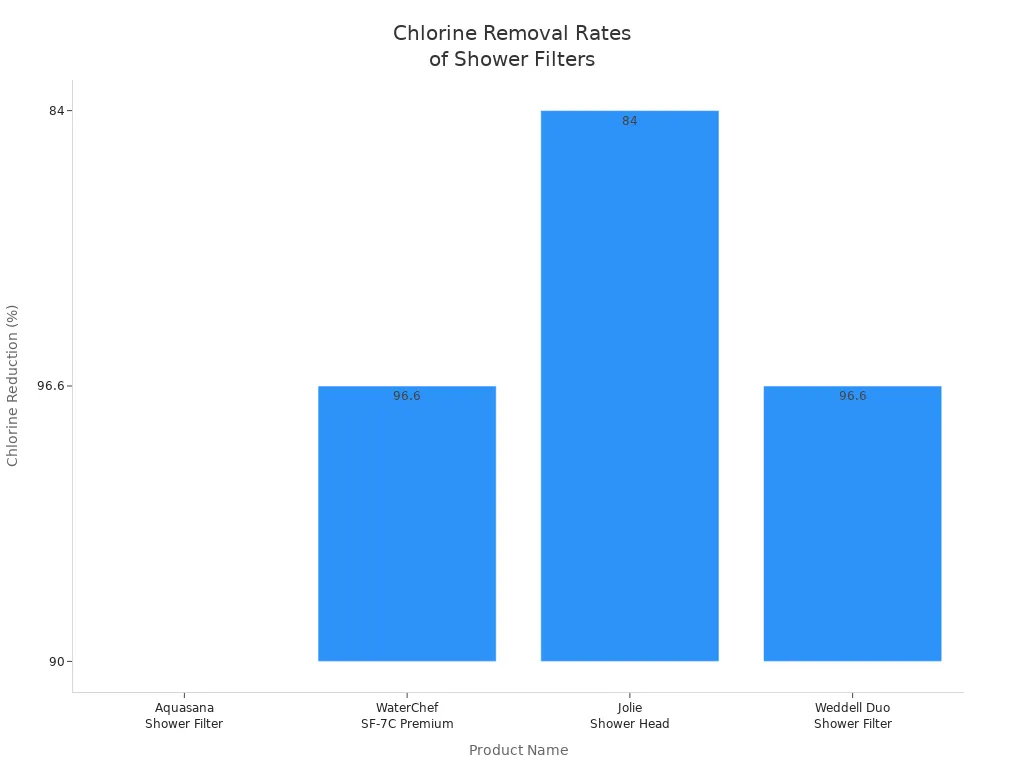
The chart shows top shower head filters remove a lot of chlorine, often more than 90%. This means your water is safer for daily use.
Benefits for Skin and Hair
Filtered shower water is good for your skin and hair. Using a shower head water filter lowers chlorine, heavy metals, and other chemicals. These things can hurt your body. Studies show these contaminants can cause dryness, irritation, acne, eczema, and hair damage. Taking them out helps your skin stay moist and your hair get softer and stronger.
Doctors suggest shower head filters for people with eczema and acne. They say less chlorine and pollution can stop clogged pores and dry skin. Hard water and heavy metals can make hair thin and break. Using a shower water filter lowers these risks and helps your scalp stay healthy.
Here are some ways your skin and hair can get better:
Less dryness and less irritation
Fewer eczema and acne problems
Softer, shinier, and stronger hair
Less dandruff and fewer scalp issues
Healthier and more moist skin
Filtered water keeps your natural oils safe. This protects your skin and hair from bad things. Over time, you will see smoother skin and healthier hair.
Tip: Using a shower head filter often can really help. You may feel the difference in just a few weeks.
Multi-Stage Filtration
Multi-stage filtration systems give you strong protection from many impurities. These filters have several layers. Each layer targets certain contaminants. The Cobbe DS Filter Shower Head is a good example of this technology.
A normal multi-stage shower head filter has:
Polypropylene mesh to catch dust and dirt
KDF-55 for redox reactions that lower chlorine and heavy metals
Calcium sulfite for fast chlorine removal, even in hot water
Activated carbon to trap chemicals and bad smells
Mineral stones to add good minerals and balance pH
This mix gives you broad impurity reduction and good purification. You get protection from chlorine, heavy metals, dirt, and other bad things. Multi-stage filters also help soften water. This makes it nicer for your skin and hair.
Note: The Cobbe DS Filter Shower Head uses more than 50% KDF-55 and calcium sulfite balls, plus mineral stones, for strong multi-stage filtration. This design makes sure you always get clean, healthy water in your shower.
Multi-stage filtration systems are great because they fight many types of contaminants at once. You do not have to worry about missing any big pollutants. You get all the good things from filtered water every time you shower.
Comparing Shower Head Filters
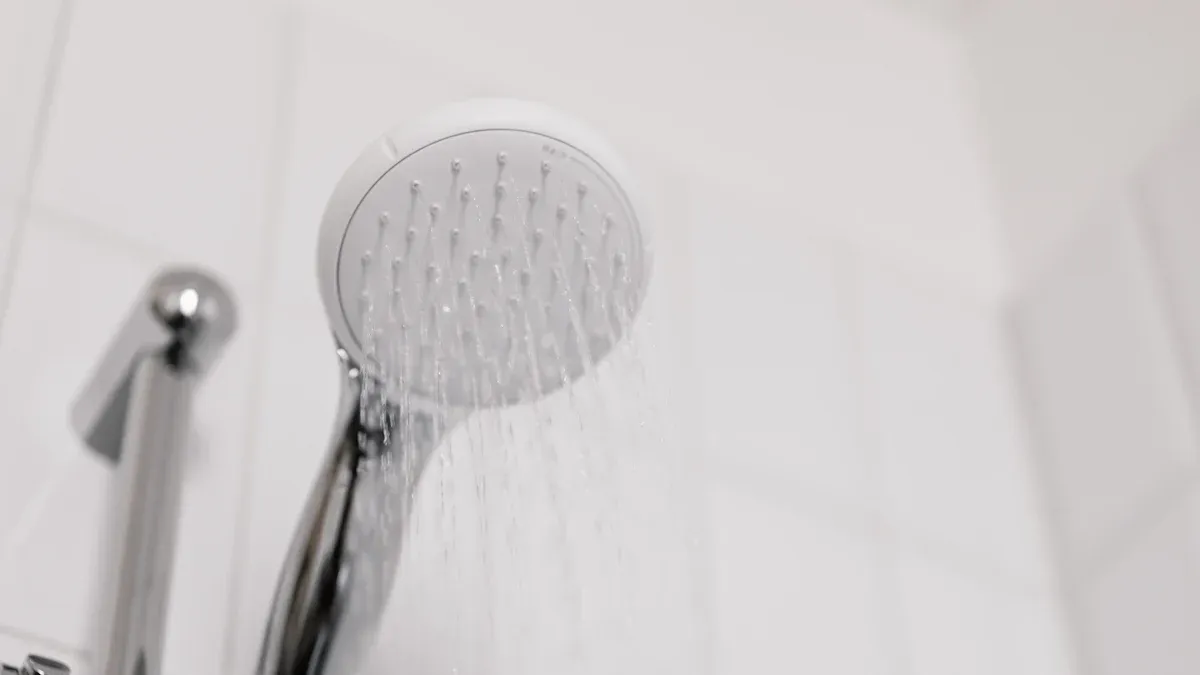
Effectiveness
When you look at shower head filters, you want to know how well they clean water. Each filter uses different materials and ways to work. Some are better at taking out chlorine. Others focus on heavy metals or bad smells. Multi-stage filters, like the Cobbe DS Filter Shower Head, use many technologies together for the best results.
Here is a table that shows how well top shower head filters remove chlorine:
Product Name |
Chlorine Removal Efficiency |
Certification/Testing Standard |
|---|---|---|
Aquasana Shower Filter Wand |
Over 90% |
NSF/ANSI Standard 177 (independent) |
WaterChef SF-7C Premium Filter |
96.6% |
NSF/ANSI Certified by IAPMO |
Over 99% (multi-stage system) |
Internal testing |
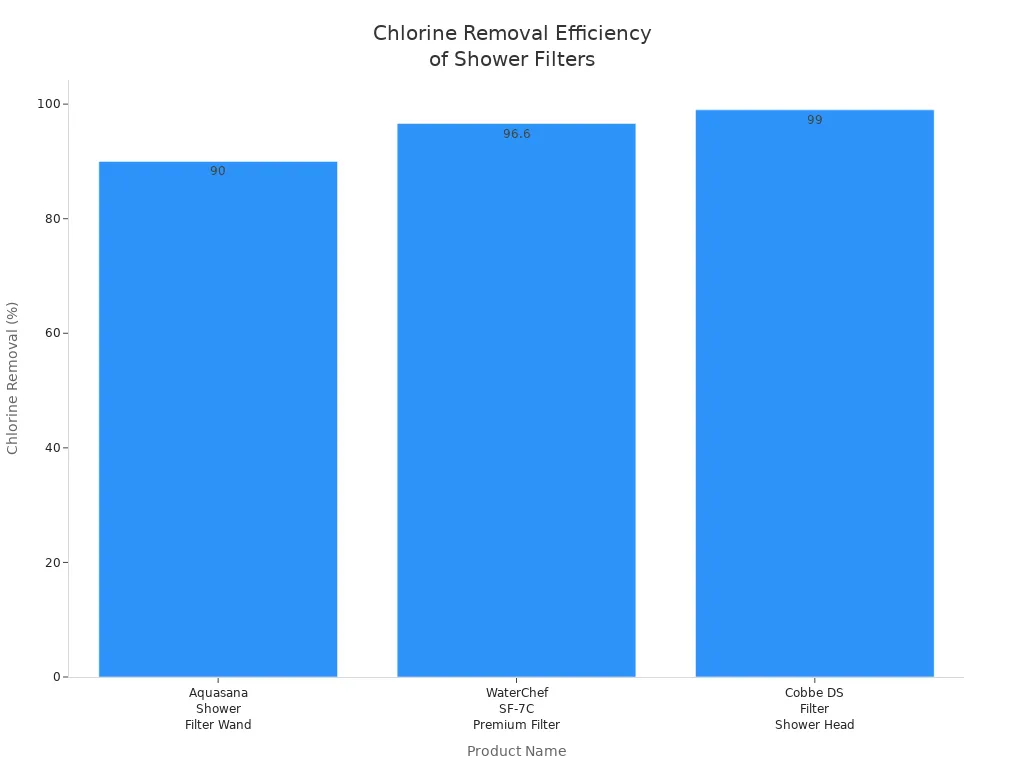
You can see that multi-stage filters with KDF-55 and calcium sulfite remove the most chlorine. These filters make your water better and help keep your skin and hair safe.
Pros and Cons
Every filter type has good and bad points. You should think about these before picking a filter for your shower.
Pros |
Cons |
|
|---|---|---|
Activated Carbon |
Removes chlorine and odors; improves water quality; helps skin and hair |
Needs frequent replacement; may lower flow rate |
KDF (Copper-Zinc) |
Removes heavy metals and chlorine; reduces scale |
Needs more frequent replacement; can be bulky |
Calcium Sulfite |
Fast chlorine removal; works in hot water |
Needs regular replacement; may use more water |
Vitamin C |
Neutralizes chlorine; gentle on skin and hair |
Fewer spray options; may lack certifications |
Mineral Stones |
Adds minerals; improves water quality |
Needs higher pressure; basic appearance |
Polypropylene Mesh |
Blocks sediment; protects other filters |
Limited filtration; may lower flow rate |
Tip: Multi-stage filters use these materials together. This gives you better protection and cleaner water.
Best Use Cases
Pick a shower head filter based on your water and what you need. Here are some common problems and the best filters for each one:
High chlorine levels: Use filters with KDF-55, calcium sulfite, or activated carbon. These take out chlorine fast and keep your water safe.
Sensitive skin or hair: Vitamin C and multi-stage filters help stop dryness and irritation.
Heavy metals in water: KDF-55 and zeolite filters remove lead, mercury, and other metals.
General water quality improvement: Multi-stage filters, like the Cobbe DS Filter Shower Head, give you strong protection and better water for daily showers.
You can test your water before buying a filter. This helps you choose the right one for your home. Change your filter often to keep your water clean and your showers healthy.
Maintenance and Replacement
Filter Lifespan
You want your shower head filter to work well every day. Most companies say you should change your filter every 4 to 6 months. If your water is very hard or your family is big, change it every 2 to 3 months. The kind of filter you use also changes how long it lasts. Here is a table that shows how long common filters last:
Filter Technology |
Average Lifespan Under Typical Household Conditions |
|---|---|
Standard Carbon Filter |
About 6 months or about 10,000 gallons filtered |
KDF Filter |
Around 6 to 9 months |
Vitamin C Filter |
Usually 2 to 3 months |
How hard your water is, how much dirt is in it, and how much water you use can change when you need a new filter.
Replacement Tips
You can keep your shower head filter working well by doing a few easy things:
Test your water. If it is hard or has lots of dirt, change your filter more often.
Look for signs your filter needs changing. If water pressure drops, smells weird, looks dirty, or you see dirt, get a new filter.
Clean the filter case every month. This stops mold and germs from growing.
Make a schedule for changing your filter. Write it on your calendar or set a phone reminder so you remember.
Pick filters that are easy to take apart or have lights that show when to change them. These make cleaning and changing fast and easy.
Tip: Cleaning often and changing your filter on time helps it last longer and keeps your water clean.
Cost Considerations
You might wonder how much it costs to take care of your shower head filter. Both multi-stage and single-stage filters need new cartridges every few months. Cartridges cost between $8 and $30, depending on the brand and type. Most shower head filters cost $30 to $79 when you buy them. Over a year, multi-stage and single-stage filters cost about the same to keep working. You do not pay more for multi-stage filters. If you change your filter every 4 to 6 months, you will spend a fair amount to keep your water safe and clean.
You can pick from many shower head water filters. Each type works best for different needs.
KDF-55 and calcium sulfite take out chlorine and heavy metals. You must change the cartridge often.
Activated carbon grabs chemicals and smells. It can get blocked if your water is hard.
Multi-stage filters protect you the most. They usually last longer than single filters.
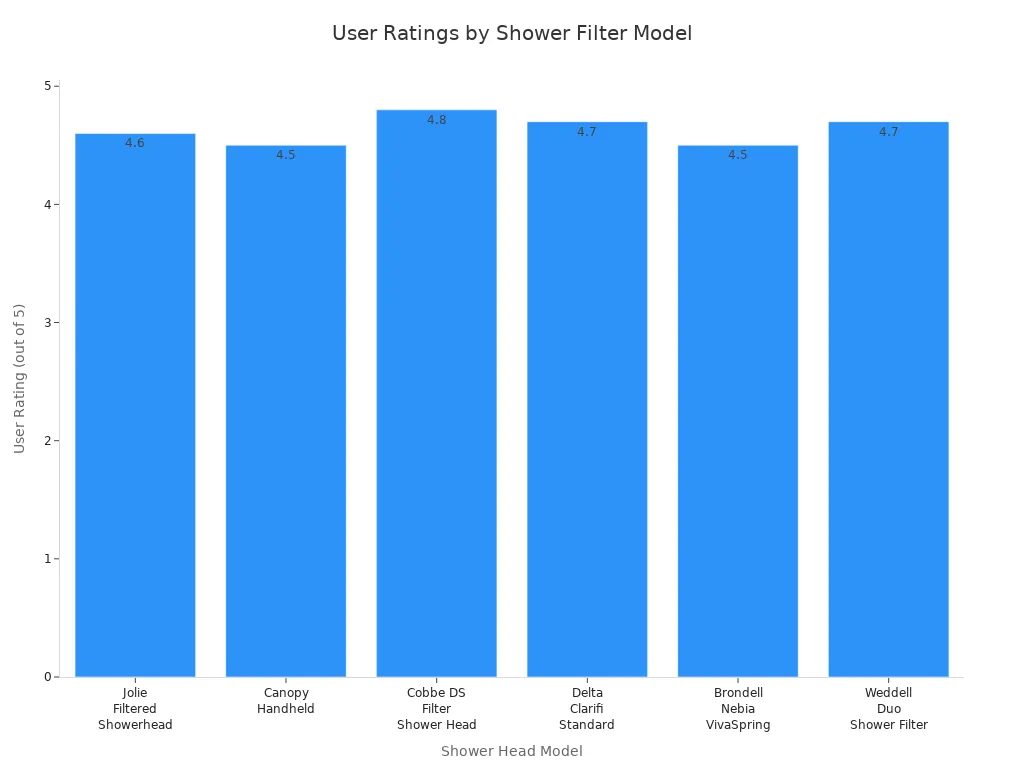
“The Cobbe DS Filter Shower Head gave us strong filtration. It is easy to use. Families who want cleaner water and a shower they can adjust will like it.” — Paul Rankin, expert product reviewer
Test your water before you buy a filter. Think about your skin and hair needs. Decide how often you want to change filters. Pick a filter that fits your life and helps you feel safe.
FAQ
What does a shower head water filter remove from my water?
A shower head water filter takes out chlorine and heavy metals. It also lowers chemicals, toxins, and other bad things in your water. This means you get cleaner water every time you shower. Your water quality gets better, so your showers are safer.
How often should I replace my filtered shower head cartridge?
You need to change your shower head cartridge every 2 to 6 months. The exact time depends on how much water you use and how clean your water is. Changing it often keeps your water clean and the filter working well.
Do vitamin C shower filters really help my skin and hair?
Vitamin C shower filters can lower chlorine and some chemicals. You might see less dryness and less irritation on your skin and hair. These filters work best when used with other strong filtration technology.
Can a shower head that filters water improve water pressure?
Many shower head filters keep water pressure strong. Some have special designs to keep the flow high while cleaning the water. You get both clean water and a powerful shower at the same time.
What are the benefits of multi-stage filtration in shower head filters?
Multi-stage filtration uses different layers like activated carbon and KDF. These layers take out more impurities and lower chlorine. You get water with fewer bad things and more benefits for your skin and hair.






